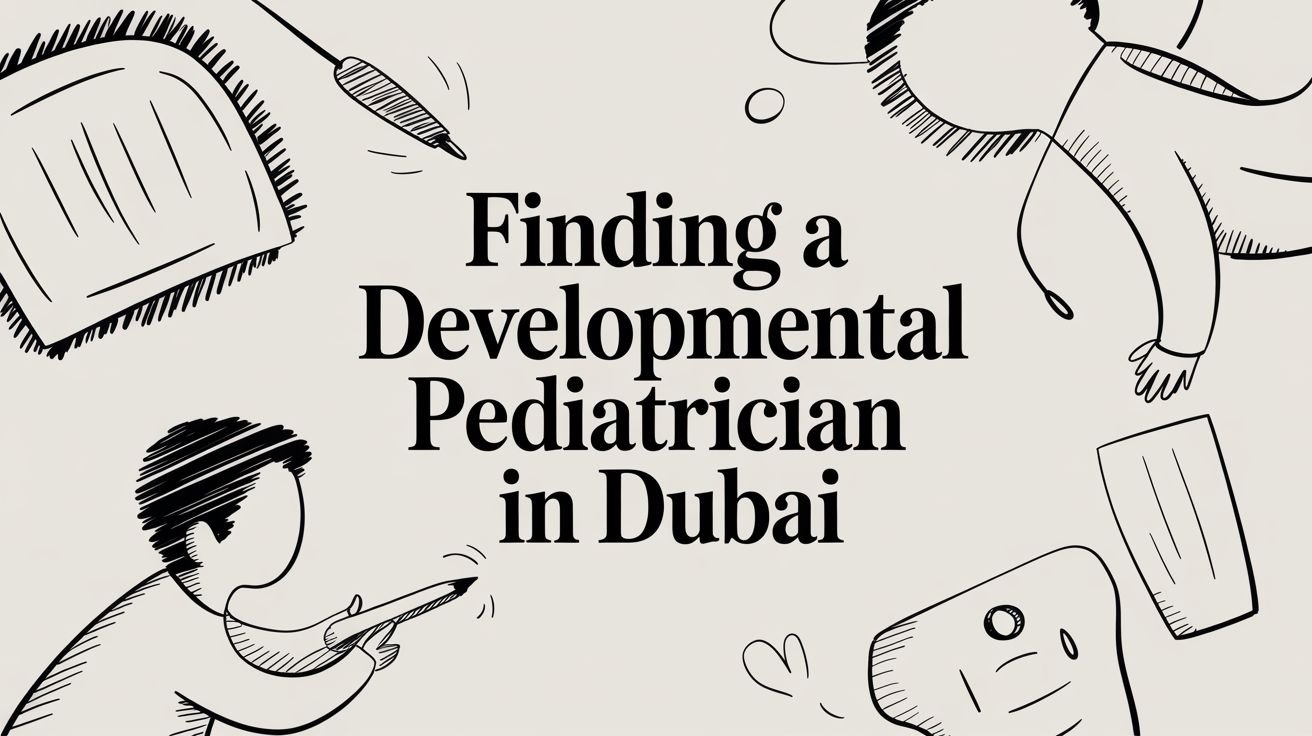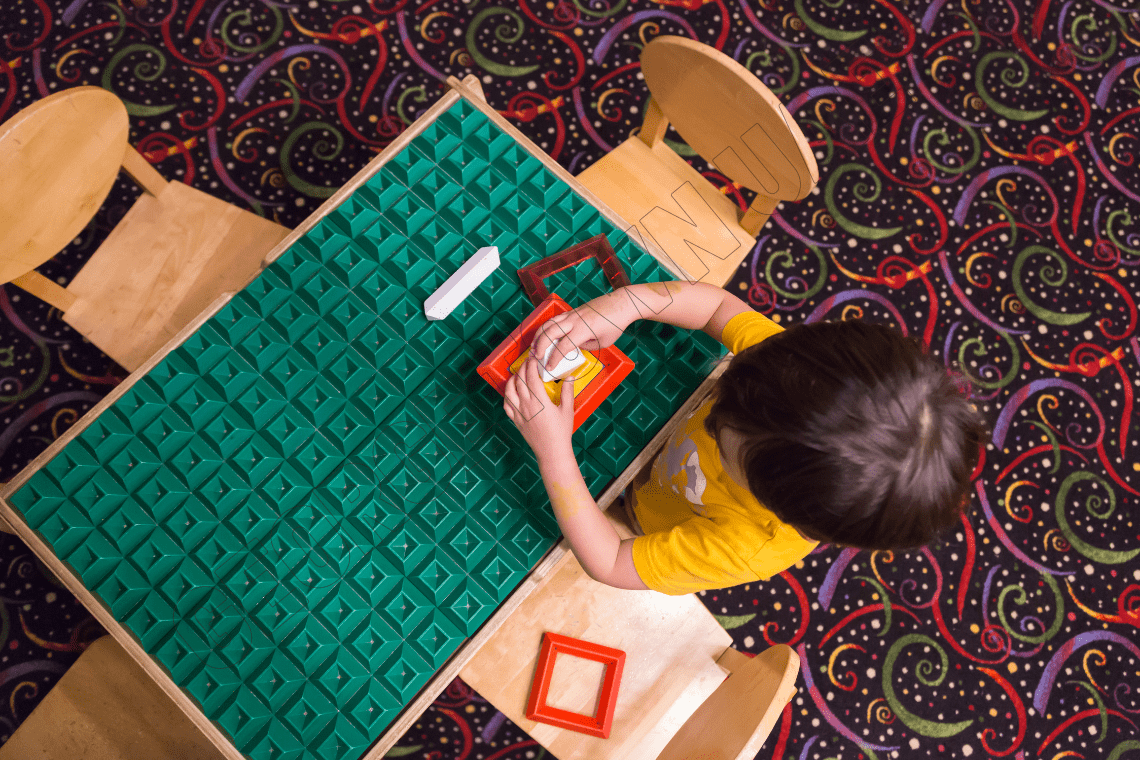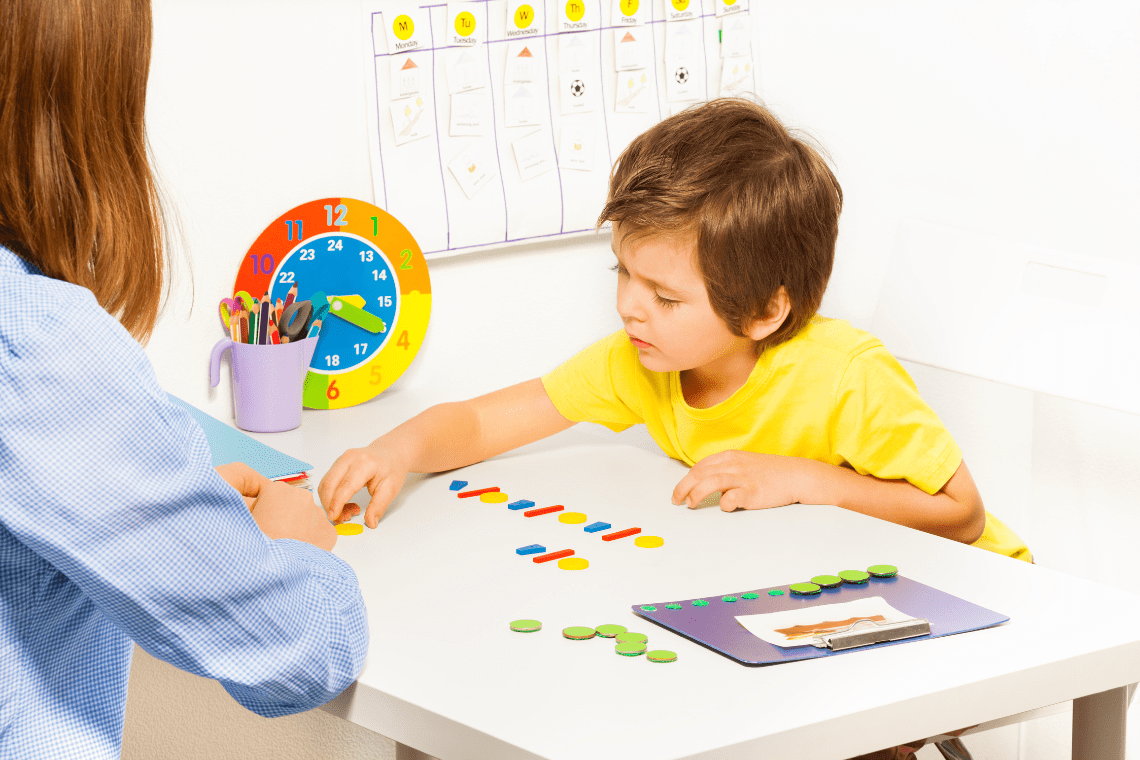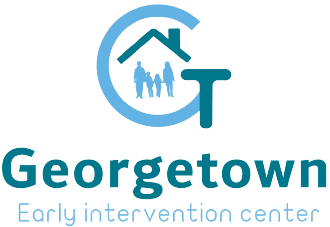Speech and language therapy is a specialized field dedicated to helping people of all ages sharpen their communication skills. It's designed to help individuals overcome challenges with speaking, understanding, and expressing their thoughts and feelings.
Unlocking Communication Potential Through Therapy
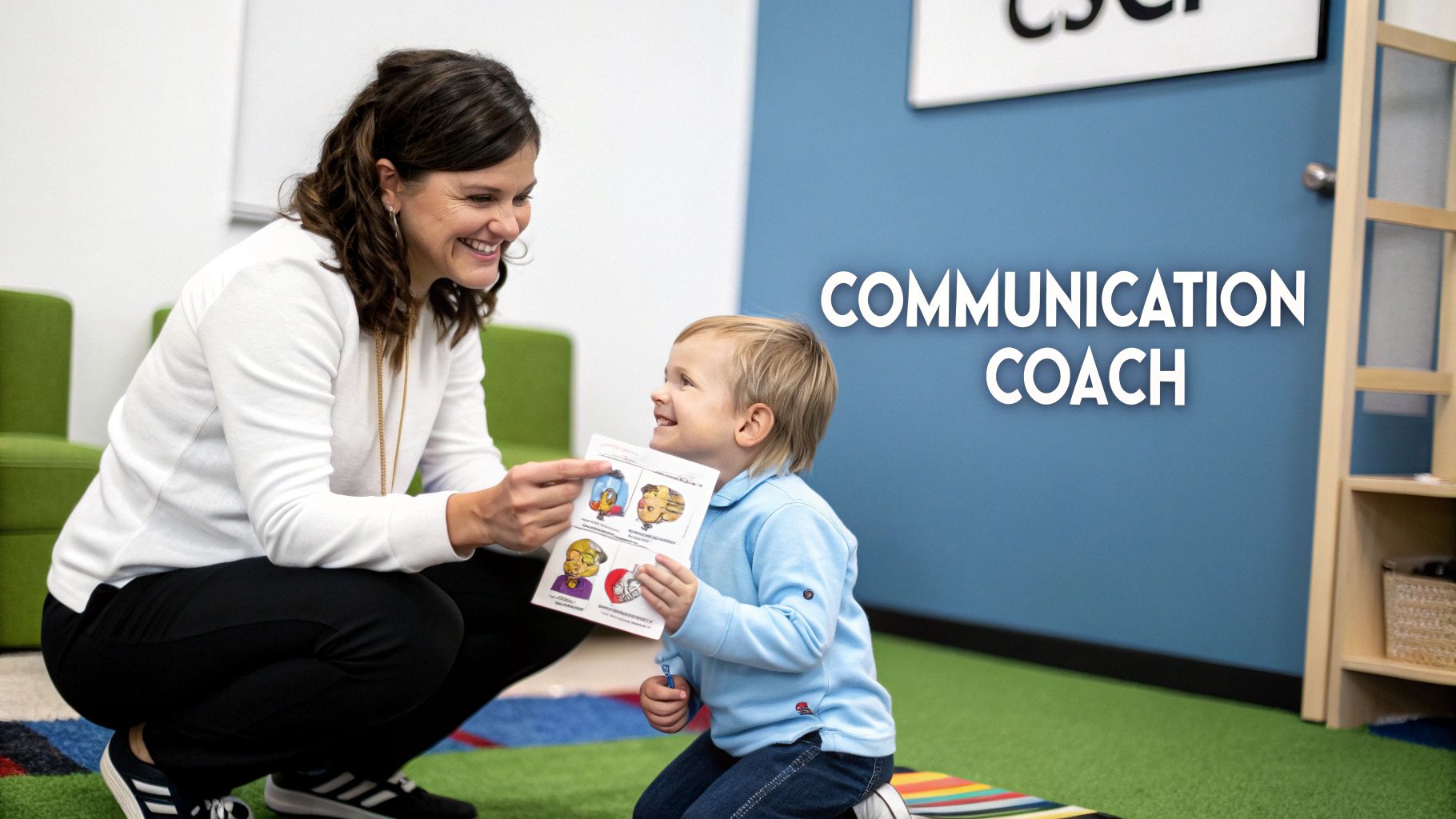
Think of a speech-language pathologist (SLP) as a personal coach for communication. These highly trained professionals work to build the essential skills we all need for connection, expression, and understanding in our daily lives. While many people think this therapy is just for correcting a lisp or a stutter, its true scope is far broader.
In reality, speech and language therapy supports a massive range of challenges. It can be life-changing for a toddler who’s struggling to say their first words, just as it can be for an adult relearning how to speak after a stroke. The work an SLP does is carefully designed for each person, creating a unique plan to meet specific, meaningful goals.
The Core Pillars of Communication
Effective therapy is built on four fundamental areas of communication. Getting to know these pillars helps clarify what the process actually targets:
- Articulation: This is all about the physical act of producing speech sounds. It’s how the lips, tongue, and jaw coordinate to form words clearly.
- Language: This covers two big jobs: understanding what others are saying (receptive language) and expressing your own thoughts and ideas (expressive language).
- Fluency: This relates to the natural rhythm and flow of speech. Therapy here often addresses issues like stuttering, helping to build smooth and confident communication.
- Voice: This pillar focuses on the quality of the voice itself—things like pitch, volume, and tone, which are all managed by our vocal cords and breath support.
At its heart, speech and language therapy is not just about fixing problems—it’s about building bridges. It empowers individuals with the tools they need to share their voice, connect with others, and participate more fully in their world.
Recognizing the need for support is always the first step. For children, early intervention is especially crucial because communication skills are the bedrock for learning, making friends, and succeeding in school. Tackling challenges early on can prevent them from snowballing into bigger obstacles down the road.
This guide will walk you through these concepts in more detail, from spotting the early signs to understanding modern therapeutic techniques. Whether it's for your child, a family member, or even yourself, learning about speech and language therapy is a proactive step toward unlocking communication potential. It's a journey of building confidence, one word at a time.
Recognizing The Signs For Early Intervention
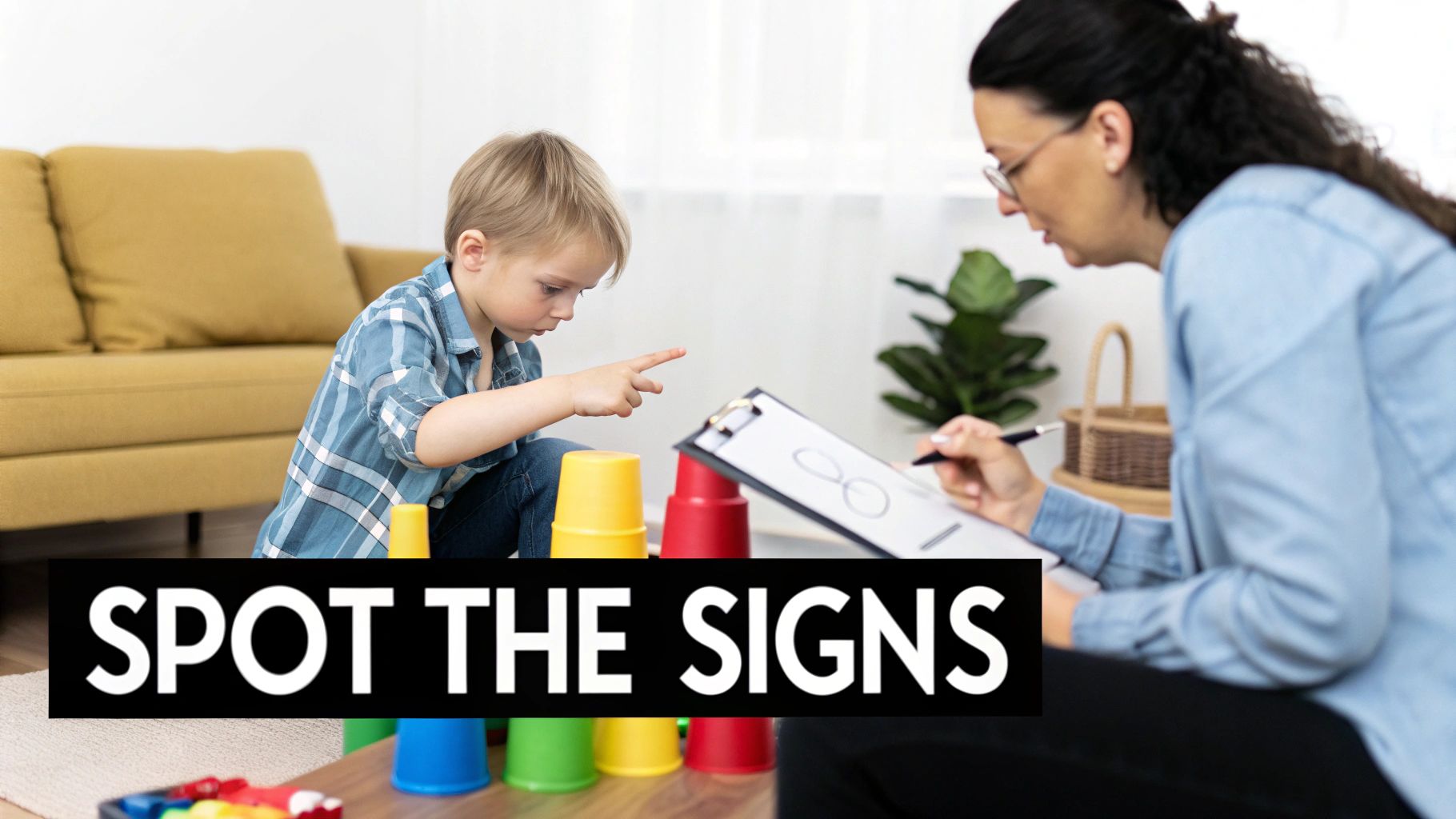
As a parent, you are the world’s foremost expert on your child. That feeling in your gut—that little nudge telling you something might be off with their communication—is incredibly powerful. Trusting that instinct is the first step. Noticing the subtle ways they interact, understand, or try to express themselves can unlock the door to getting them the right support at just the right time. This isn't about creating worry; it's about turning that uncertainty into positive, proactive steps.
If you’re feeling concerned, you’re not alone. Communication disorders are among the most common disabilities, affecting an estimated 40 million Americans. For young children, the numbers are just as significant, with 8-9% experiencing some form of speech sound disorder. These aren’t just numbers; they represent families just like yours looking for answers.
An evaluation for speech and language therapy isn't a sign that anyone has failed. Think of it as a supportive tool to make sure your loved one has everything they need to connect with the world around them. When it comes to a child’s development, early intervention is everything. It builds a solid foundation for learning, making friends, and growing into a confident individual.
Key Milestones In Early Childhood
Children tend to develop communication skills in a fairly predictable pattern, but it's important to remember that every child moves at their own pace. These milestones aren't a rigid checklist but a helpful guide to know what to generally expect.
This simple table breaks down some of the key skills to watch and listen for as your little one grows.
Developmental Milestones Checklist For Early Speech And Language
| Age Range | What to Listen For (Speech) | What to Look For (Language & Understanding) |
|---|---|---|
| By 12 Months | Babbling with different sounds ("bababa," "mamama"). Starting to imitate sounds. | Responds to their own name. Uses gestures like pointing or waving bye-bye. |
| By 18 Months | Says several single words with meaning. | Follows simple, one-step directions like "Come here" or "Give me the ball." |
| By 2 Years | Puts two words together in simple phrases ("more juice," "my toy"). Vocabulary is growing. | Points to pictures in a book when named. Understands simple questions. |
| By 3 Years | Uses three-word sentences. Speech is understood by familiar listeners most of the time. Asks "why?" | Can follow two-step commands. Understands concepts like "in" and "on." |
If you're noticing your child isn't consistently hitting these markers, it might be a sign they could use a little extra help. For a more in-depth look, this practical guide to speech development milestones is a fantastic resource for parents.
Trusting your gut feeling is essential. If you feel that something isn't quite right with your child's communication development, it is always worth discussing with a professional. Early support can make a world of difference.
The impact of getting help at the right time is profound. You can learn more about this in our article on the importance of early intervention in child development.
Common Signs In Adults
For adults, communication challenges often show up differently, sometimes appearing quite suddenly after a medical event like a stroke or as part of a progressive condition. Being able to spot these changes is the first step toward recovery and regaining confidence.
Here are a few key indicators to watch for in adults:
- Slurred or Unclear Speech (Dysarthria): This can happen when the muscles used for speech become weak. The person’s speech might sound slow, mumbled, or strained, making them difficult to understand.
- Difficulty Finding Words (Aphasia): This is incredibly frustrating for the individual. They know exactly what they want to say, but the right words just won't come out. They might use a related word instead ("chair" instead of "table") or try to describe the object.
- Trouble Understanding Others: Following a conversation, especially with multiple people, can become overwhelming. They might frequently ask for things to be repeated or misunderstand questions.
- Changes in Voice Quality: The voice itself can change, becoming hoarse, unusually quiet, or breathy. This can signal a voice disorder or another underlying health concern.
Whether it’s for your child or an adult family member, seeking an evaluation is a powerful, proactive step. A speech and language therapy assessment provides clear answers and, most importantly, a personalized roadmap to build stronger, more confident communication skills.
The Four Pillars of Communication Therapy
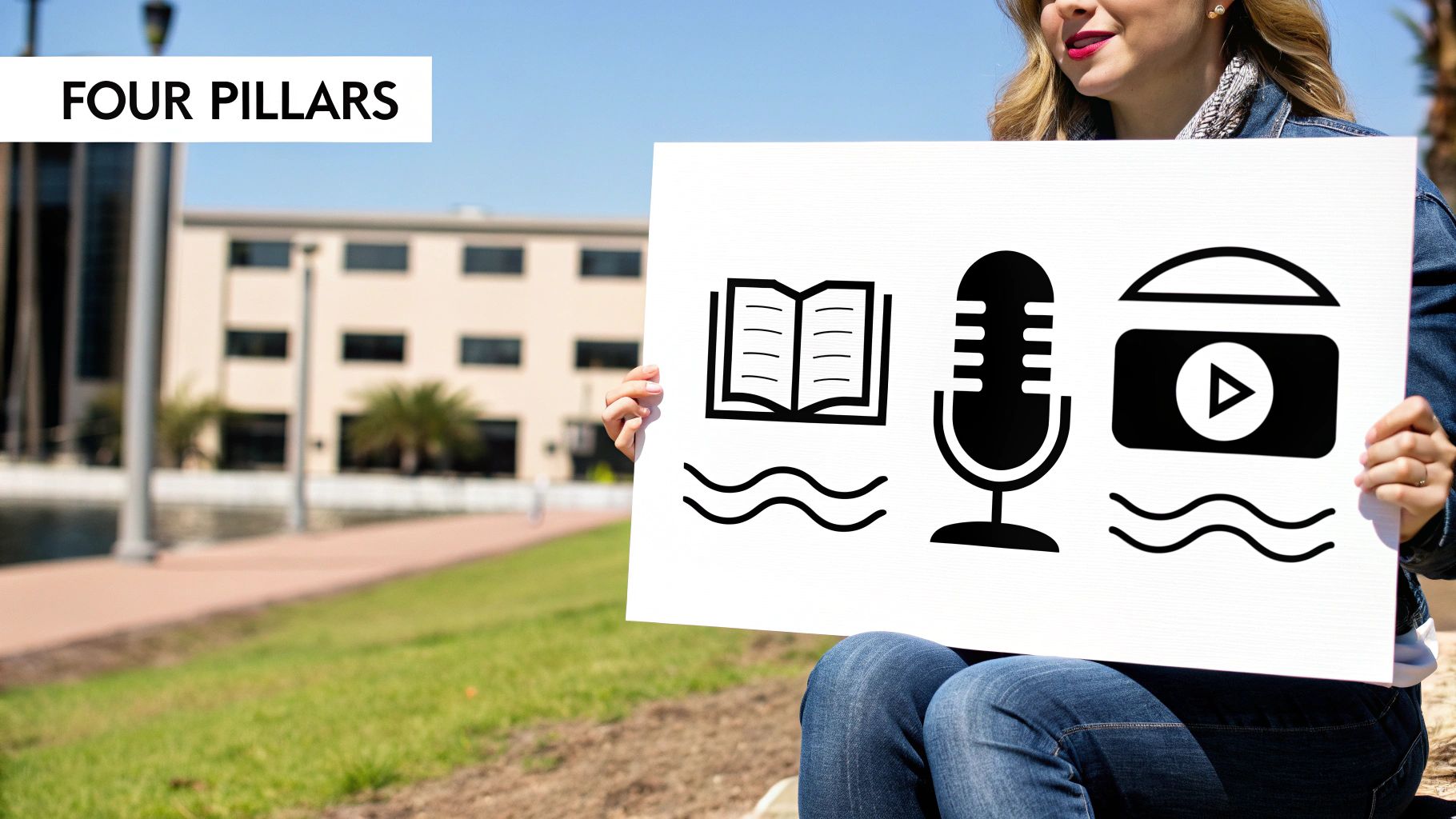
To really get a handle on speech and language therapy, it helps to picture communication as a structure built on four core pillars. A speech-language pathologist (SLP) is like a skilled builder, carefully checking the strength of each pillar and drawing up a blueprint to reinforce any that need support.
When we break down the complex world of communication this way, it's much easier to see where a child might be struggling and how targeted therapy can make a real difference.
Pillar 1: Articulation – The Mechanics of Speech
Articulation is all about the physical act of making sounds. It’s the precise, coordinated dance between the tongue, lips, teeth, and jaw. If you think about it, it's an incredible motor skill.
When this pillar isn’t quite solid, sounds can get twisted, dropped, or swapped out for others. You might hear a child say "wabbit" instead of "rabbit," which is a classic example of substituting one sound for another. This is what we call an articulation disorder. The child knows the word, but their mouth just isn't making the right moves yet.
Therapy for articulation is like coaching for the mouth. We work on teaching the muscles how to move correctly, building muscle memory until forming sounds becomes second nature.
Pillar 2: Language – The Blueprint for Meaning
Language is the very heart of communication—it's the meaning behind the words. This pillar has two sides that work together:
Receptive Language: This is all about understanding. It’s the ability to process what you hear or read and make sense of it. A child with a receptive language challenge might have trouble following directions or keeping up with a story.
Expressive Language: This is the flip side—using words, sentences, and gestures to share your own thoughts and feelings. It's about getting your message out into the world.
A well-known language disorder is aphasia, which can happen after a stroke. Someone with aphasia might know exactly what they want to say but can't find the words. It’s like having a thought perfectly clear in your mind, but the connection to your mouth is blocked.
Speech and language therapy for language challenges focuses on building vocabulary, understanding grammar, and organizing thoughts into clear sentences. It's about giving a child the tools they need to both understand and be understood.
Pillar 3: Fluency – The Rhythm and Flow
Fluency is the smooth, forward-moving rhythm of speech. It's what makes conversations feel easy and natural. When there are bumps in the road, the whole flow of communication can be disrupted.
The most common fluency disorder is stuttering. It shows up as interruptions in the flow of speech, like:
- Repetitions: Repeating sounds or words (e.g., "li-li-like this").
- Prolongations: Stretching out a sound (e.g., "Ssssssometimes").
- Blocks: Getting completely stuck on a word, with no sound coming out.
Therapy for fluency isn't about "curing" the stutter. Instead, it provides practical strategies to manage the rhythm of speech, reduce physical tension, and build confidence. The goal is to give the speaker more control and make talking feel less stressful.
Pillar 4: Voice – The Quality of the Sound
Last but not least, the voice pillar governs the sound itself—its pitch, volume, and quality. It’s all about how the breath from the lungs works with the vocal cords to produce sound.
Voice disorders can make someone sound hoarse, breathy, or nasal. The voice might be too loud, too quiet, or just strained. These issues can pop up from overuse (like a teacher who talks all day), medical conditions, or even just bad habits.
For example, a coach who constantly shouts might develop vocal nodules, leading to a chronically raspy voice. Speech and language therapy for voice issues often feels like vocal coaching—we work on healthy habits, proper breath support, and how to use the voice without causing damage.
By looking at these four pillars, it’s clear that speech therapy is a highly specific process, tailored to strengthen the exact foundations of a child’s communication needs.
Modern Therapeutic Approaches and Techniques

The world of speech and language therapy isn't stuck in the past; it’s a dynamic field that’s constantly evolving. Think of a speech-language pathologist (SLP) as a skilled artisan with a diverse toolbox. They don't just pull out the same tool for every job. Instead, they carefully select the right instruments and methods to fit the unique needs of every person they help.
There's no such thing as a one-size-fits-all formula in therapy. It's a journey we build together, tailored to each individual's specific communication profile. What works wonders for one child might not click with another. That’s why modern SLPs blend structured drills with natural, activity-based learning to create an environment where a child can truly grow. The goal is always to build skills that are practical and meaningful in the real world.
Play-Based Therapy: Learning Through Joy
For young children, play isn't just for fun—it's how they learn and communicate. It's their primary language. Play-based therapy taps into this natural instinct, weaving communication goals right into activities a child already loves. So, instead of sitting at a table doing drills, a child might be building with blocks, hosting a tea party, or making a zoo with toy animals.
During these activities, the therapist subtly guides the interaction to hit specific targets. While playing with a farm set, for example, the therapist might model animal sounds to work on articulation ("The cow says moo!") or ask questions that encourage two-word phrases ("Where is the pig?"). This approach makes therapy feel like playtime, which lowers the pressure and makes a child genuinely excited to communicate.
The real magic of play-based therapy is that it teaches communication skills in the exact context where they’ll be used. It builds a bridge from the therapy room to the child's world, making it so much easier for new skills to stick.
Structured Approaches for Targeted Skill-Building
While play is fantastic, some challenges need a more direct and structured game plan. These methods are designed to zoom in on specific skills, using repetition and immediate feedback to build mastery. They're especially powerful for addressing the physical mechanics of producing speech sounds.
Here are a couple of examples of structured techniques:
- Articulation Therapy: This is a classic approach where we use drills to teach the correct placement of the tongue, lips, and jaw for certain sounds. A therapist might use a mirror, diagrams, or even gentle touch to help a child see and feel how to properly make a sound like /r/ or /s/.
- Oral Placement Therapy (OPT): This technique uses a mix of auditory, visual, and tactile feedback to improve speech clarity. It really hones in on the motor skills of speech, helping to build the muscle strength and coordination needed for crisp, clear sounds. You can learn more about how we use speech enhancement through Oral Placement Therapy in the UAE in our detailed guide.
These focused methods provide the dedicated practice required to build muscle memory and make new speech patterns feel natural and automatic.
Technology in Speech and Language Therapy
Modern technology has opened up some incredibly exciting doors for communication support. One of the biggest game-changers is Augmentative and Alternative Communication (AAC). These systems aren't meant to replace speech, but to support it, giving a reliable way to express oneself to individuals facing severe communication challenges.
AAC can be as simple as a picture board or as advanced as a high-tech device that generates speech. These tools empower non-verbal or minimally verbal individuals to share their wants, needs, thoughts, and feelings, unlocking their ability to connect with their community.
The field is always moving forward with new tech; for instance, AI voice recognition in healthcare is starting to help with diagnosis and progress monitoring. This constant innovation shows just how vital this profession is. In fact, the U.S. speech therapy market was valued at USD 4.91 billion in 2024 and is expected to grow to USD 9.08 billion by 2032, driven by greater awareness and new technologies.
What to Expect from Your Therapy Journey
Stepping into speech and language therapy for the first time can feel a little uncertain. What happens? How does it all work? It helps to have a clear roadmap, so you know exactly what to expect from the first conversation to the moment you’re celebrating real, tangible progress.
Think of this process as a partnership. It’s not something that’s done to a person, but a journey we take with them and their family. This collaboration is the secret sauce—it ensures the goals we set are meaningful, the strategies we use are practical, and every win is celebrated together.
The Initial Assessment
Everything kicks off with a comprehensive assessment. This is much more than just a chat; it's a deep dive into an individual’s complete communication profile. Our speech-language pathologists (SLPs) use a blend of tools to get the full picture.
This evaluation usually involves a few key things:
- Standardized Tests: These help us compare an individual's skills to others in their age group, giving us a clear benchmark.
- Informal Observation: We watch how a person communicates in a natural setting. For a child, this might be during playtime; for an adult, it’s often just a relaxed conversation.
- Parent and Client Interviews: Hearing directly about the communication history, daily struggles, and personal strengths is absolutely essential for creating a plan that actually works.
Think of the SLP as a friendly detective during this phase, gathering all the clues needed to understand which parts of communication need a little extra support.
Collaborative Goal Setting
Once the assessment gives us a clear picture, we move on to setting goals. This is where the teamwork really shines. The therapist, client, and family all sit down together to decide what success will look like. The focus is always on creating functional targets—goals that will make a genuine difference in day-to-day life.
For a toddler, a goal might be as simple as using two-word phrases to ask for a snack, which can dramatically cut down on frustration. For an adult recovering from a stroke, it could be feeling confident enough to order their own coffee again.
The most effective therapy goals are the ones that truly matter to the individual. They aren't just clinical benchmarks; they are personal milestones that unlock greater independence and connection.
These goals become the blueprint for the entire therapy plan. We make sure they are specific, measurable, and above all, motivating.
What Therapy Sessions Look Like
Therapy sessions are where the plan springs into action. Each session is carefully designed to be both engaging and productive. Especially for kids, it often feels more like guided play than hard work. Our SLPs use a variety of proven techniques to work toward the goals we’ve set together. A typical session includes direct instruction, lots of practice, and immediate, supportive feedback.
Progress isn’t just checked at the end—it's monitored constantly. The SLP keeps detailed notes on what’s working and what’s not, allowing the therapy plan to be flexible. If one approach isn’t getting the results we want, we’ll adjust our strategy. This ensures every single session is moving the individual forward.
Finally, the partnership extends beyond our doors. A huge part of success comes from the practice that happens at home. Your therapist will give you plenty of guidance and fun activities to reinforce new skills between visits. For extra support, our guide on speech exercises to do at home with your child has practical ideas to keep the momentum going. When the family is actively involved, skills learned in therapy quickly become lifelong habits.
The Growing Role of Speech and Language Professionals
Behind every child’s breakthrough in communication is a dedicated professional known as a speech-language pathologist (SLP). These specialists are the true architects of connection, blending scientific knowledge with a deep sense of empathy to build personalized pathways toward clearer speech.
Their role has never been more vital, and the demand for these skilled professionals is soaring. This growth comes from two main places: an aging population needing support for conditions like strokes, and a much greater awareness of developmental delays in children, which means more kids are getting the early help they need.
A Diverse and Expanding Field
The world of an SLP is anything but one-dimensional. These experts work across a huge range of settings, adapting their skills to meet the unique needs of different people. It’s this flexibility that makes them such a core part of both our healthcare and education systems.
You’ll find SLPs making a real difference in places like:
- Public and Private Schools: Helping children overcome communication hurdles that stand in the way of their academic and social success.
- Hospitals and Rehabilitation Centers: Working with patients recovering from brain injuries or strokes that have affected their ability to speak or even swallow.
- Private Practices: Offering focused, one-on-one therapy for a wide variety of communication disorders across all ages.
- Early Intervention Centers: Like Georgetown, which centers on giving kids critical support during their most formative years.
This variety really highlights how essential the profession is. As our understanding of communication health grows, the need for qualified SLPs only gets stronger, proving the immense value they bring to our communities.
A Profession in High Demand
The numbers back this up, showing a major need for more speech and language professionals. Employment for SLPs is projected to grow between 15% and 19% from 2023 to 2034—a rate that blows past the average for all other jobs.
That translates to roughly 13,300 to 13,700 job openings every single year, pointing to a career path that’s not just fulfilling but also incredibly stable. You can find more insights on the rising demand for SLPs on AdvancedTherapyClinic.com.
The expanding role of speech-language pathologists reflects a fundamental shift in how we view communication. It is no longer seen as a soft skill but as an essential component of overall health, education, and quality of life.
This growing recognition cements the SLP's place as a cornerstone of modern wellness and education. For anyone thinking about this career, it’s a chance to make a tangible, lasting impact on people’s lives every single day.
Your Questions Answered
When you're exploring speech and language therapy, it's natural to have questions. Getting answers helps you feel confident and prepared for the journey ahead. Here, we tackle some of the most common things parents and caregivers ask.
How Long Does Therapy Usually Last?
This is one of the first questions on every parent's mind, and the honest answer is: it’s different for every child. There's no fixed schedule because every therapy plan is built around an individual's unique needs and goals.
Some children working on specific speech sounds might see wonderful progress in just a few months. For others with more complex challenges, like those related to developmental disorders or recovery from an injury, therapy might be a longer-term part of their support system. The focus is always on making steady, meaningful progress that helps them in their daily life.
How Can I Find a Qualified Therapist?
Finding the right professional is the most important first step. A great place to start is by asking your child's pediatrician for a referral; they often have a network of trusted specialists they work with. Your child’s school can also be a valuable resource, as they frequently partner with speech-language pathologists (SLPs).
When you’re looking, make sure the therapist is certified and licensed. In the United States, for example, a qualified SLP will have a Certificate of Clinical Competence (CCC-SLP) from the American Speech-Language-Hearing Association (ASHA). Most importantly, you want to find someone who connects well with your child and your family. A positive, trusting relationship makes all the difference.
The ultimate goal of speech and language therapy isn't just about correcting errors; it's about building confident, effective communicators who can fully participate in their lives.
What Is the Difference Between a Speech and a Language Disorder?
It’s easy to get these two mixed up, but they refer to different aspects of communication. Knowing the difference helps you understand what your therapist is focusing on.
- A speech disorder is about the mechanics of talking—the physical act of producing sounds. This includes things like articulation (saying sounds clearly), fluency (stuttering), and voice (the quality or volume of the sound).
- A language disorder is about understanding and using the meaning behind words. This can involve challenges with understanding what others say (receptive language) or expressing one's own thoughts and ideas (expressive language). It’s about the message itself, not just how it’s spoken.




